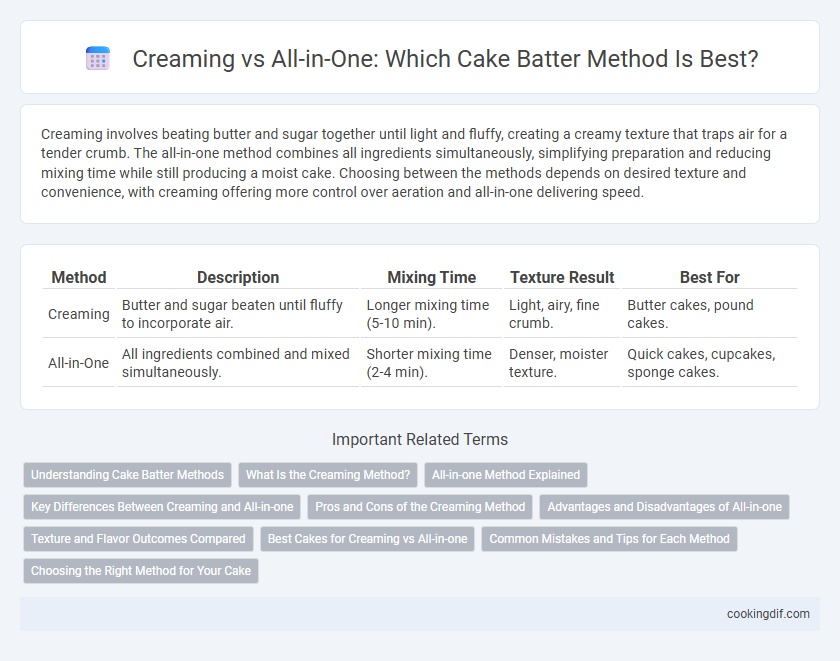Creaming involves beating butter and sugar together until light and fluffy, creating a creamy texture that traps air for a tender crumb. The all-in-one method combines all ingredients simultaneously, simplifying preparation and reducing mixing time while still producing a moist cake. Choosing between the methods depends on desired texture and convenience, with creaming offering more control over aeration and all-in-one delivering speed.
Table of Comparison
| Method | Description | Mixing Time | Texture Result | Best For |
|---|---|---|---|---|
| Creaming | Butter and sugar beaten until fluffy to incorporate air. | Longer mixing time (5-10 min). | Light, airy, fine crumb. | Butter cakes, pound cakes. |
| All-in-One | All ingredients combined and mixed simultaneously. | Shorter mixing time (2-4 min). | Denser, moister texture. | Quick cakes, cupcakes, sponge cakes. |
Understanding Cake Batter Methods
Creaming and all-in-one methods significantly affect cake texture and rise due to their mixing techniques. Creaming involves beating butter and sugar together to incorporate air, resulting in a light, fluffy crumb, ideal for butter cakes. The all-in-one method combines all ingredients simultaneously, streamlining preparation but often producing denser cakes, suitable for simple or quick recipes.
What Is the Creaming Method?
The creaming method involves beating butter and sugar together until light and fluffy, creating tiny air pockets that help produce a tender, airy cake texture. This technique is essential for incorporating eggs and dry ingredients gradually, ensuring an even batter consistency and better rise during baking. Compared to the all-in-one method, creaming provides superior structure and crumb quality, especially in classic butter cakes and layer cakes.
All-in-one Method Explained
The all-in-one method involves combining all ingredients--flour, sugar, butter, eggs, and leavening agents--simultaneously before mixing, resulting in a quicker and simpler cake batter preparation. This technique promotes moisture retention and produces a tender crumb by minimizing ingredient exposure to air and reducing over-mixing risks. It is especially effective for dense cakes like pound cakes or loaf cakes where even texture and efficient preparation are prioritized.
Key Differences Between Creaming and All-in-one
Creaming method involves beating butter and sugar together until light and fluffy, incorporating air to create a tender and fine crumb in cakes. All-in-one method combines all ingredients simultaneously, offering a quicker process but potentially resulting in a denser texture due to less aeration. Understanding these methods is essential for bakers aiming to achieve specific cake textures and crumb structures.
Pros and Cons of the Creaming Method
The creaming method for cake batter involves beating butter and sugar until light and fluffy, incorporating air that contributes to a tender, airy crumb and enhanced flavor. However, it requires room-temperature ingredients and longer mixing time, which may be less convenient for beginners or quick preparation. Overmixing can cause the batter to deflate or produce a dense texture, demanding careful attention to mixing technique.
Advantages and Disadvantages of All-in-one
The all-in-one method for cake batter simplifies the process by combining all ingredients simultaneously, saving time and reducing dishwashing. This method promotes a moist and tender crumb due to the thorough mixing of fats and liquids but can lead to over-mixing, resulting in a denser texture if not carefully monitored. Bakers should note that the all-in-one approach is less forgiving with delicate cakes, as it may compromise aeration and overall rise compared to the creaming technique.
Texture and Flavor Outcomes Compared
Creaming method incorporates air into butter and sugar, resulting in a light, fluffy cake with a tender crumb and enhanced buttery flavor, while the all-in-one method produces a denser texture with more uniform moisture distribution, often intensifying the overall flavor due to quicker ingredient blending. Creaming tends to offer better rise and finer crumb structure, ideal for sponge and butter cakes, whereas all-in-one yields a speedier mix with consistent but heavier texture, suitable for moist, rich cakes like pound cake. Texture differences stem from the aeration process in creaming, influencing crumb softness and flavor release, compared to the straightforward emulsification in all-in-one blending.
Best Cakes for Creaming vs All-in-one
Creaming method excels with butter cakes, pound cakes, and layered cakes, producing tender crumb and superior rise due to thorough incorporation of air into butter and sugar. All-in-one method suits sponge cakes, chiffon cakes, and cupcakes, offering efficiency by mixing all ingredients simultaneously while achieving lighter texture without extensive aeration. Selecting the method aligns with cake type, optimizing texture and flavor characteristics for each baking style.
Common Mistakes and Tips for Each Method
Creaming method mistakes often include overmixing, which leads to a dense texture, and under-creaming butter and sugar, resulting in insufficient air incorporation; to avoid this, beat butter and sugar until light and fluffy for optimal rise. All-in-one method errors typically involve uneven mixing, causing lumps and inconsistent crumb structure; using room temperature ingredients and mixing just until combined helps maintain batter uniformity. Both methods benefit from precise measuring and gradual ingredient addition to ensure tender, well-risen cakes.
Choosing the Right Method for Your Cake
Choosing the right cake batter method depends on the texture and flavor desired, with creaming providing a light, airy crumb by beating butter and sugar until fluffy, ideal for butter-rich cakes. The all-in-one method streamlines mixing all ingredients simultaneously, ensuring a moist and dense cake better suited for simpler recipes or quicker preparation. Understanding the structural impact of each method enhances baking outcomes, allowing customization based on cake type and baking goals.
Creaming vs All-in-one for cake batter method Infographic

 cookingdif.com
cookingdif.com